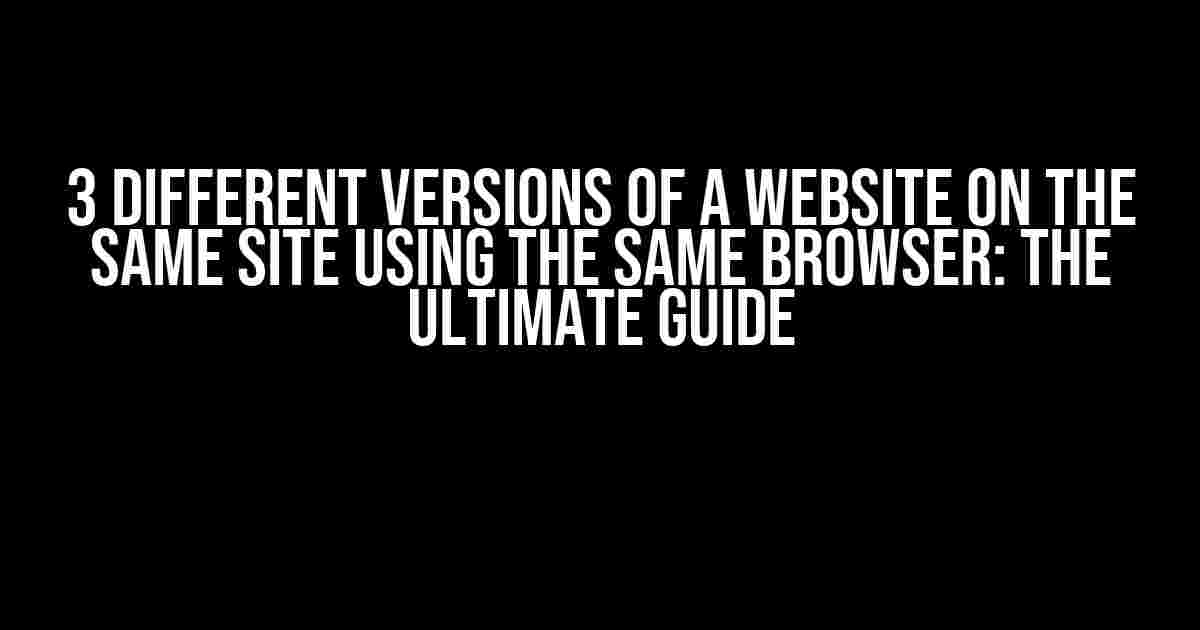Welcome to the world of website development, where creativity meets technicality! Imagine having three different versions of your website on the same site, accessible through the same browser. Sounds like magic, right? Well, it’s not magic; it’s just clever web development. In this article, we’ll take you on a journey to explore the possibilities of having multiple versions of your website coexisting peacefully on the same site, using the same browser.
Why Would You Want Multiple Versions of Your Website?
Before we dive into the technical nitty-gritty, let’s discuss the reasons behind having multiple versions of your website. Here are a few scenarios where this approach can be beneficial:
- Multi-regional support: You want to cater to different regions, each with their own language, currency, and cultural preferences. Having multiple versions of your website allows you to tailor the content, design, and functionality to specific regions.
- A/B testing and experimentation: You want to test different design, layout, or feature variations of your website to see which one performs better. Having multiple versions enables you to test and compare the performance of each version.
- Segmented audience targeting: You want to target specific audience segments, such as enterprises, individuals, or students, with customized content and features.
How to Achieve Multiple Versions of Your Website on the Same Site
Now that we’ve established the reasons, let’s explore the ways to achieve multiple versions of your website on the same site using the same browser:
Method 1: URL Parameters
One of the simplest ways to achieve multiple versions of your website is by using URL parameters. You can append a parameter to the URL, such as ?version=A, to indicate the desired version. This approach is easy to implement but has its limitations, such as:
- URL parameter can be easily modified by users.
- Not suitable for large-scale implementations.
https://example.com?version=AMethod 2: Subdomains
A more elegant approach is to use subdomains to host different versions of your website. For example:
https://version-a.example.comThis method allows you to:
- Use separate SSL certificates for each subdomain.
- Implement DNS-level routing and load balancing.
- Use different analytics and tracking codes for each subdomain.
Method 3: Cookie-Based Versioning
This method involves setting a cookie on the user’s browser to indicate the desired version. You can use JavaScript to set the cookie and then redirect the user to the corresponding version of your website.
<script>
document.cookie = "version=A";
window.location.href = "https://example.com";
</script>This approach allows you to:
- Store user preferences and persist the version across sessions.
- Use server-side rendering to customize the content based on the cookie value.
Technical Implementation and Considerations
Now that we’ve discussed the methods, let’s dive into the technical implementation and considerations:
Server-Side Rendering (SSR)
SSR enables you to render different versions of your website on the server-side, based on the URL parameter, subdomain, or cookie value. This approach allows for better SEO, improved performance, and easier maintenance.
<?php
if ($_COOKIE['version'] == 'A') {
// Render version A of the website
} else {
// Render version B of the website
}
?>Client-Side Rendering (CSR)
CSR involves rendering different versions of your website on the client-side using JavaScript. This approach allows for more flexibility and dynamic changes but can impact SEO and performance.
<script>
if (getCookie('version') == 'A') {
// Render version A of the website
} else {
// Render version B of the website
}
</script>Caching and Performance
When dealing with multiple versions of your website, caching and performance become crucial. You’ll need to implement caching mechanisms, such as:
- Cache invalidation strategies.
- Content Delivery Networks (CDNs).
- Optimized images and assets.
Analytics and Tracking
To accurately track and analyze user behavior across different versions of your website, you’ll need to:
- Use separate analytics and tracking codes for each version.
- Implement event tracking and goal conversions.
- Use A/B testing and experimentation tools.
Conclusion
Having three different versions of your website on the same site using the same browser is a complex but rewarding endeavor. By understanding the reasons behind this approach and implementing the right technical solutions, you can create a more tailored and engaging user experience. Remember to consider the technical implications, caching and performance, and analytics and tracking when embarking on this journey.
| Method | Advantages | Disadvantages |
|---|---|---|
| URL Parameters | Easy to implement, flexible | URL parameter can be modified by users, not suitable for large-scale implementations |
| Subdomains | Separate SSL certificates, DNS-level routing and load balancing, different analytics and tracking codes | Requires more infrastructure and maintenance |
| Cookies | Stores user preferences, persists across sessions, server-side rendering | Requires JavaScript, can impact SEO and performance |
By following this guide, you’ll be well on your way to creating a multi-versioned website that delights and engages your users. Happy coding!
Frequently Asked Questions
Having multiple versions of a website on the same site can be confusing, but don’t worry, we’ve got you covered!
Q: What is the concept of having multiple website versions on the same site?
A: Having multiple website versions on the same site means that a single website can have different layouts, designs, or features, catering to different user groups, languages, or devices. This approach allows for a more personalized and tailored user experience.
Q: How do I access different website versions on the same site using the same browser?
A: You can access different website versions by using different URLs, subdomains, or parameters. For example, a website might have a main site (example.com), a mobile version (m.example.com), and a beta version (beta.example.com). Alternatively, you can use URL parameters like ?version=beta to access different versions.
Q: Can I have multiple website versions open simultaneously in the same browser?
A: Yes, you can have multiple website versions open simultaneously in the same browser by using different tabs or windows. This allows you to compare and switch between different versions easily. Just make sure to use different URLs or parameters to access each version.
Q: What are the benefits of having multiple website versions on the same site?
A: Having multiple website versions on the same site offers several benefits, including improved user experience, increased accessibility, and better device compatibility. It also allows for A/B testing, experimentation, and iteration, enabling you to refine your website and improve its overall performance.
Q: Are there any challenges or limitations to having multiple website versions on the same site?
A: Yes, having multiple website versions on the same site can introduce challenges like increased maintenance costs, complexity in content management, and potential SEO implications. It’s essential to weigh these challenges against the benefits and plan carefully to ensure a seamless user experience.



